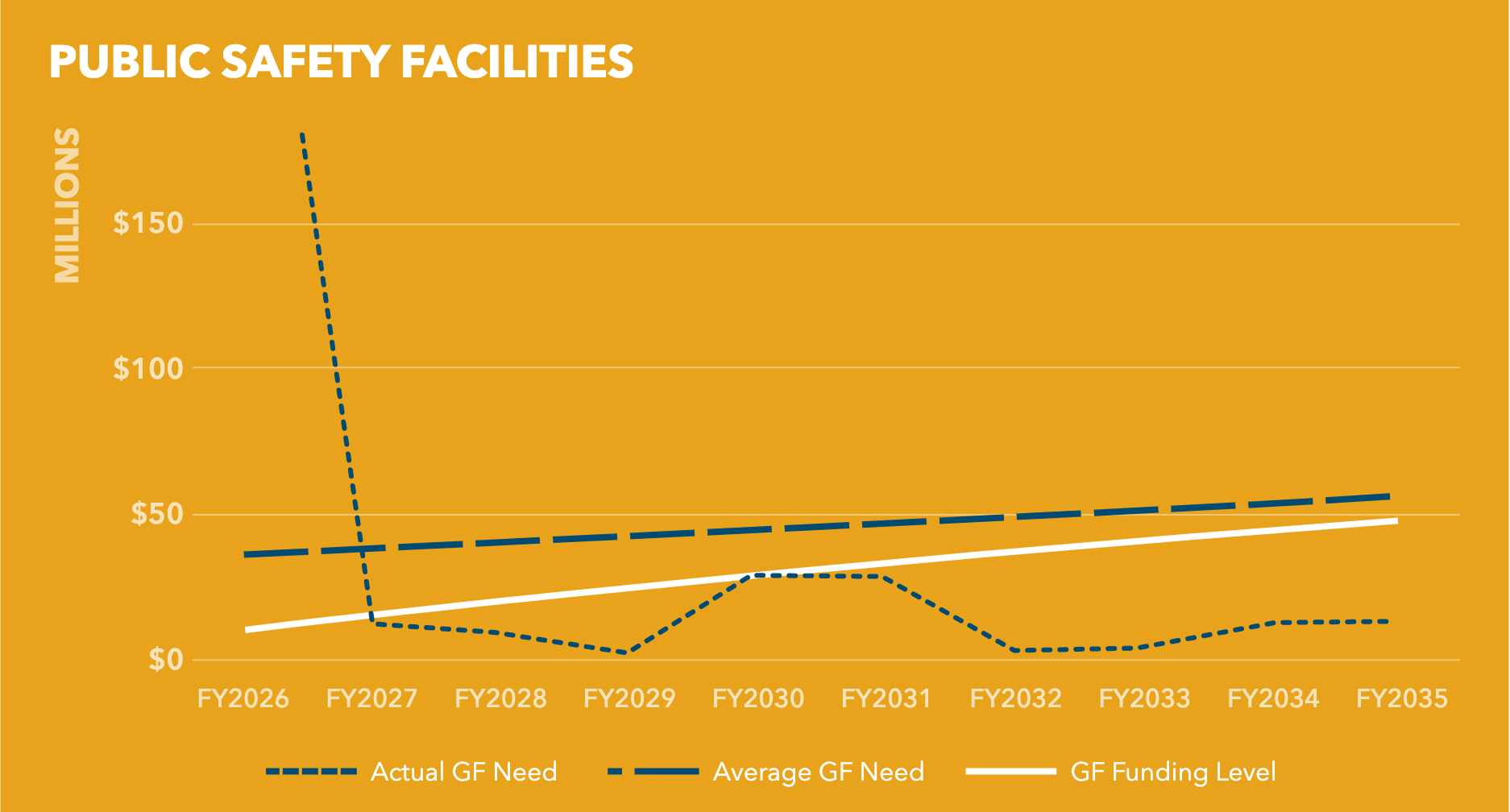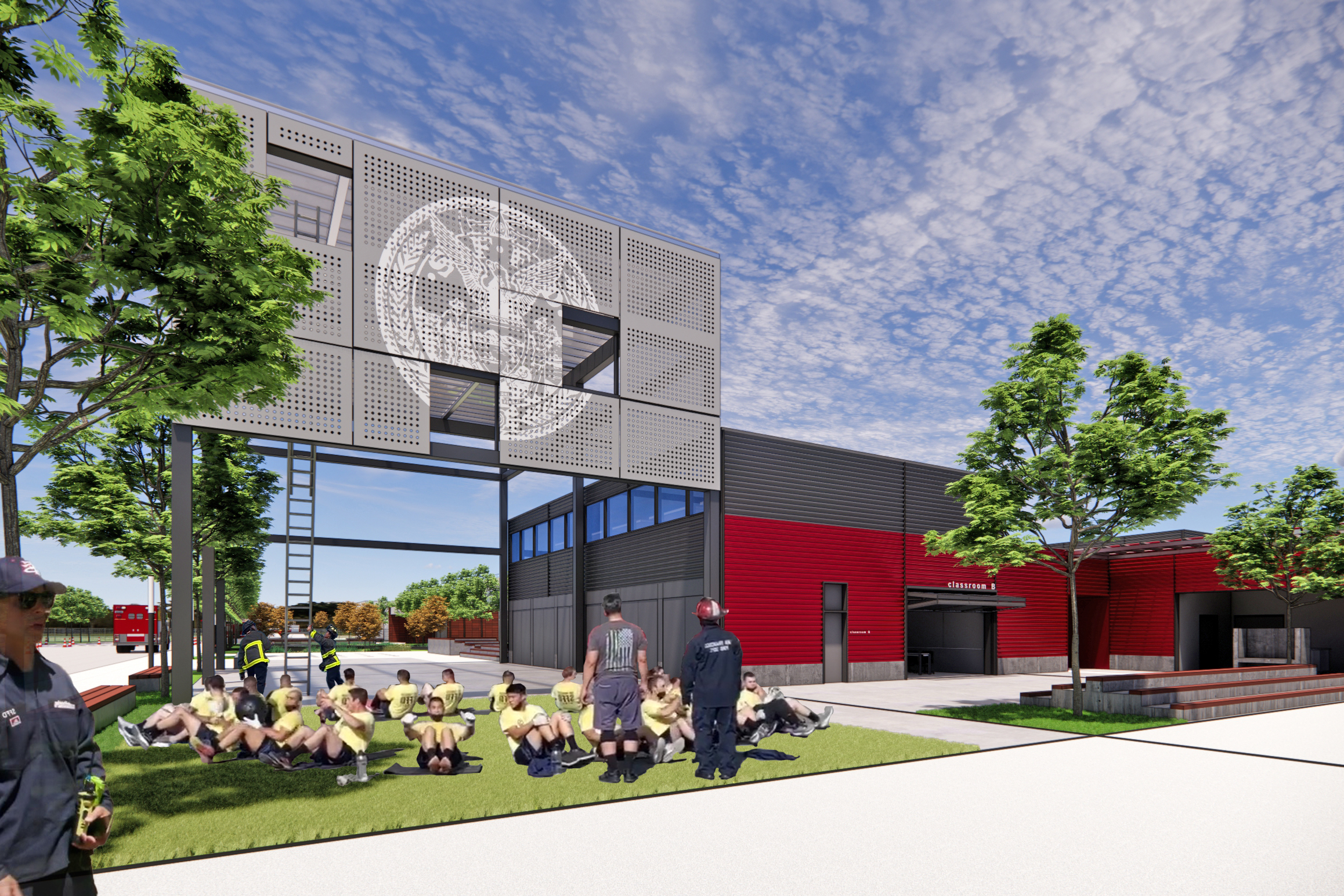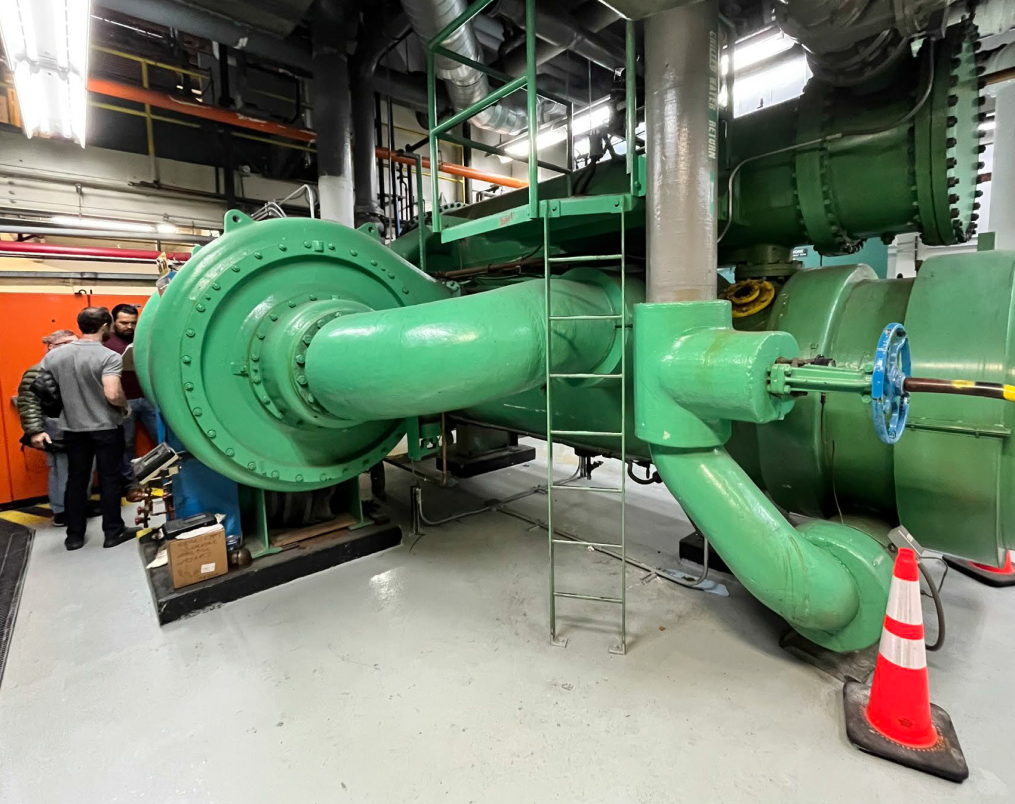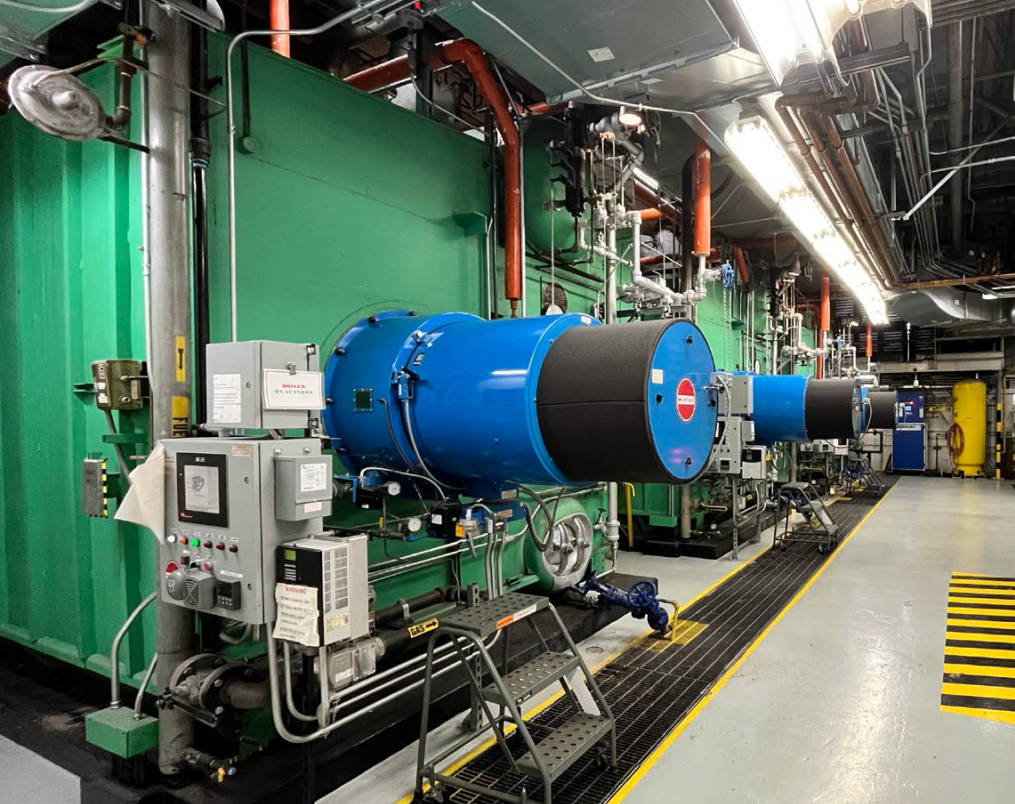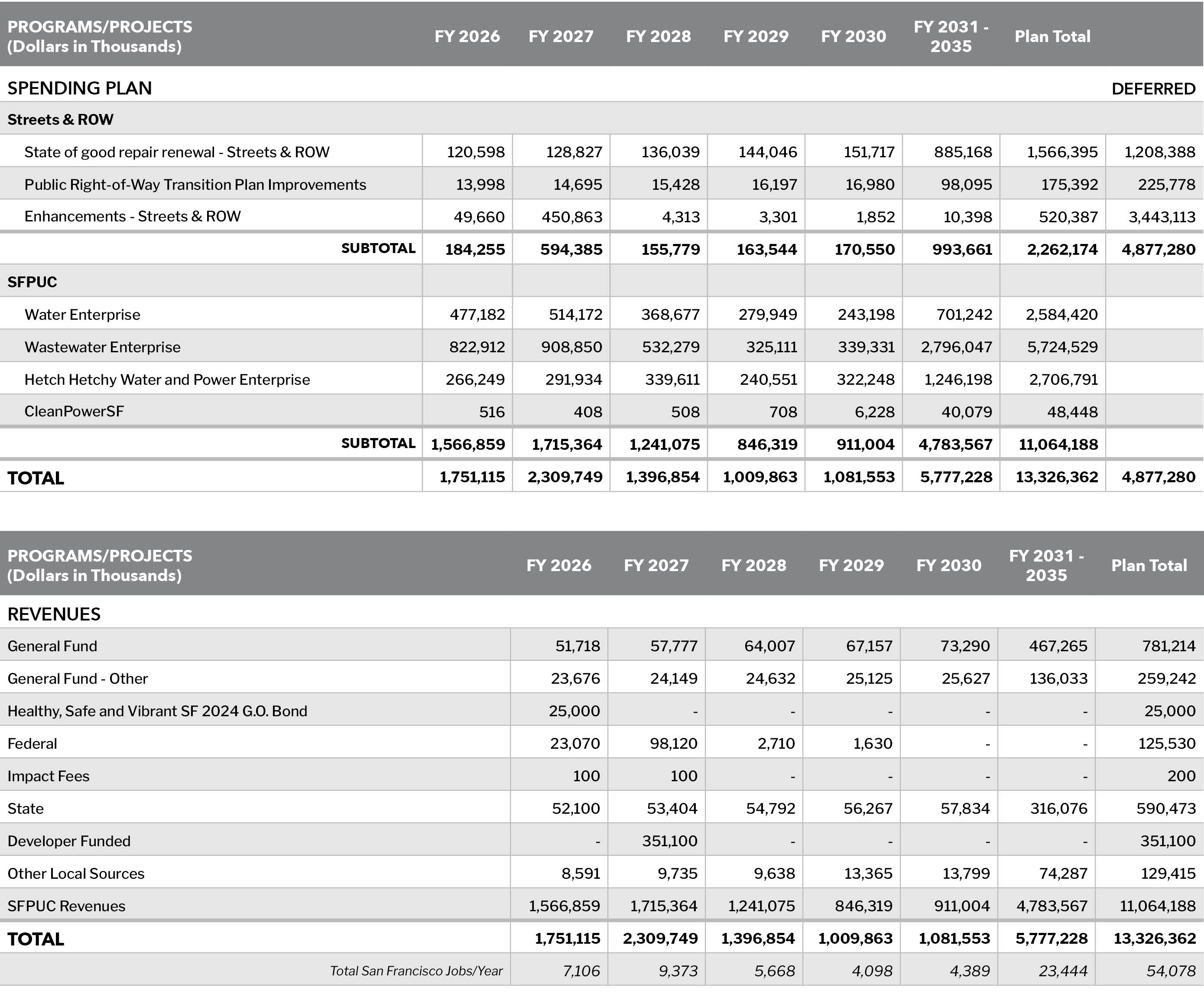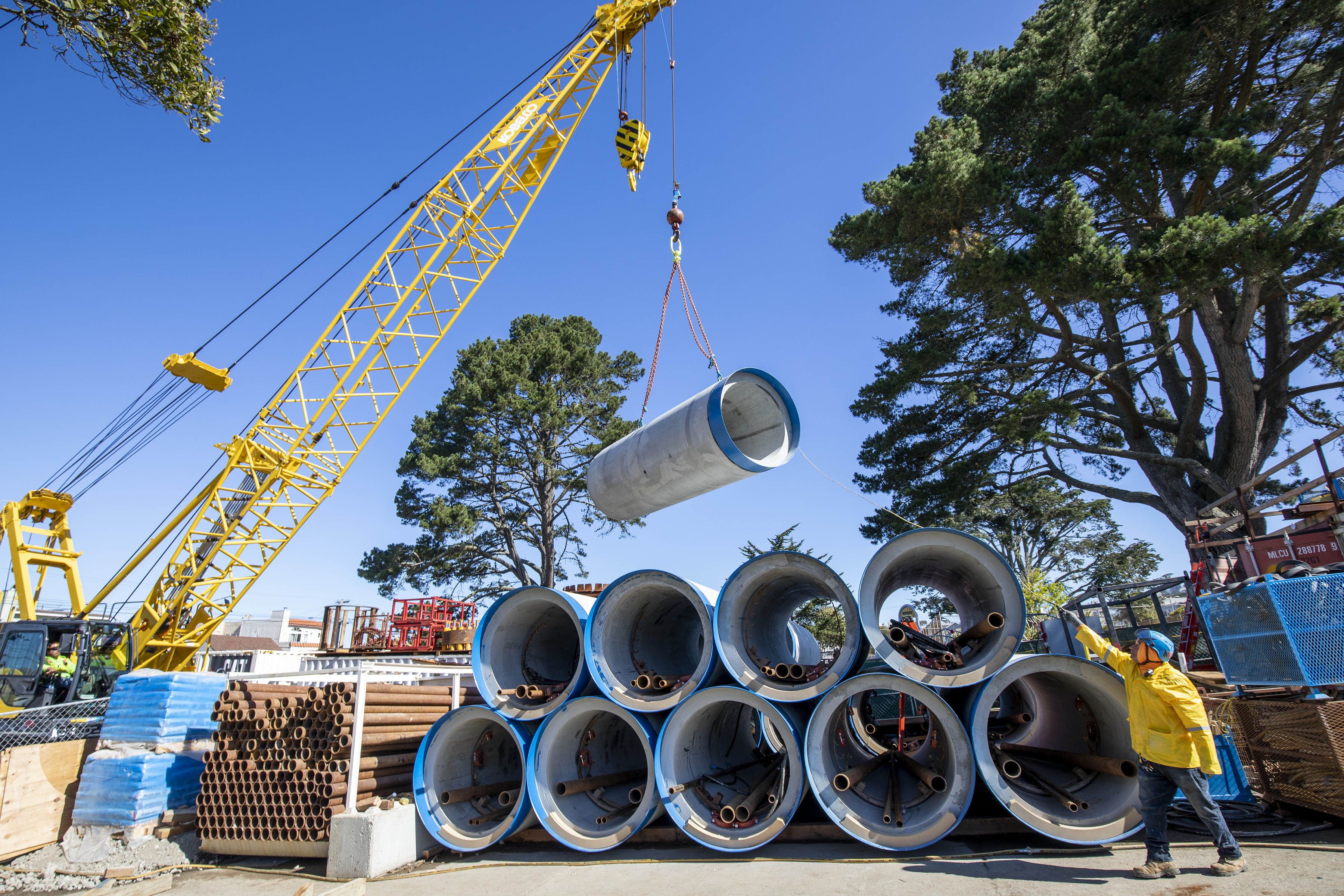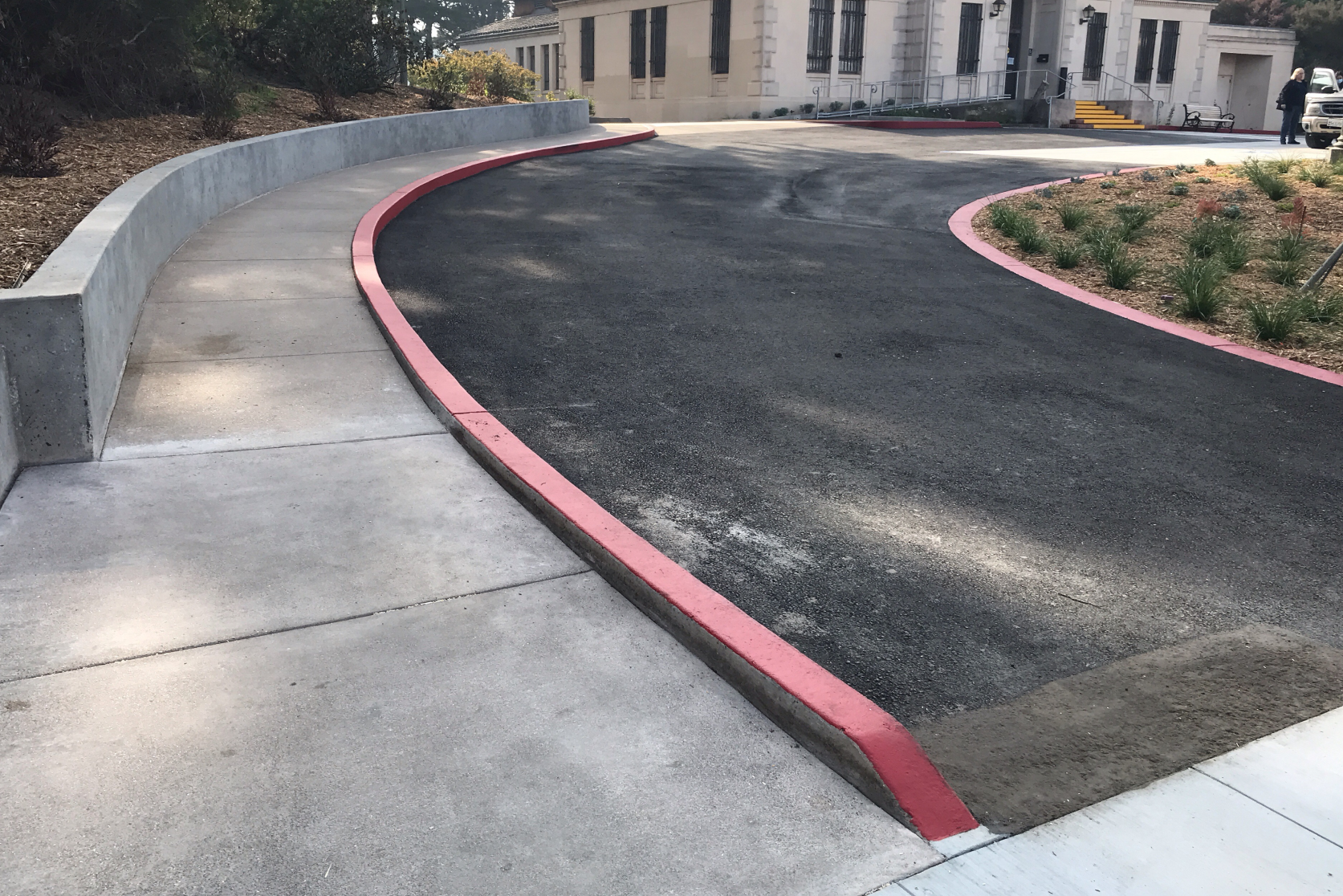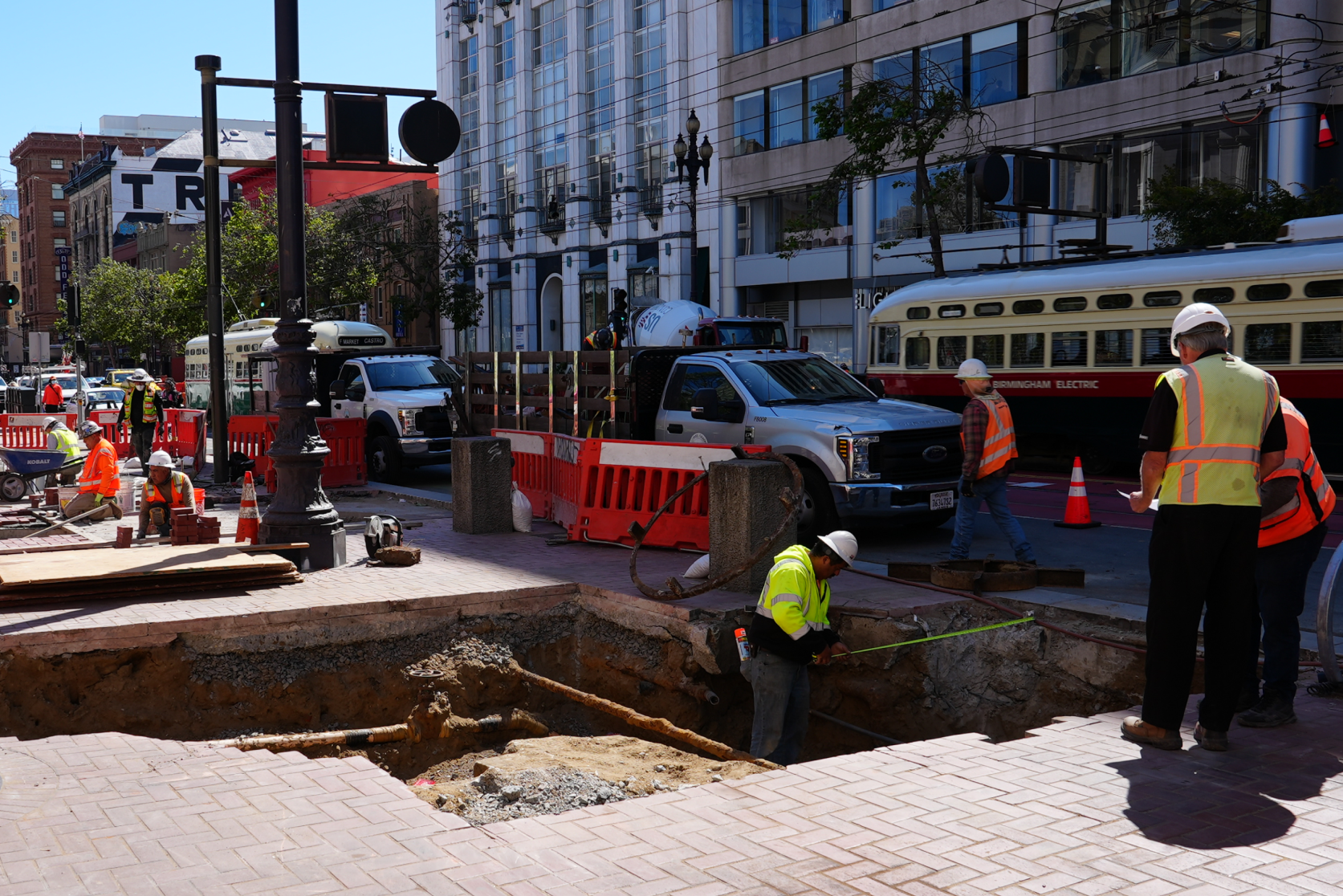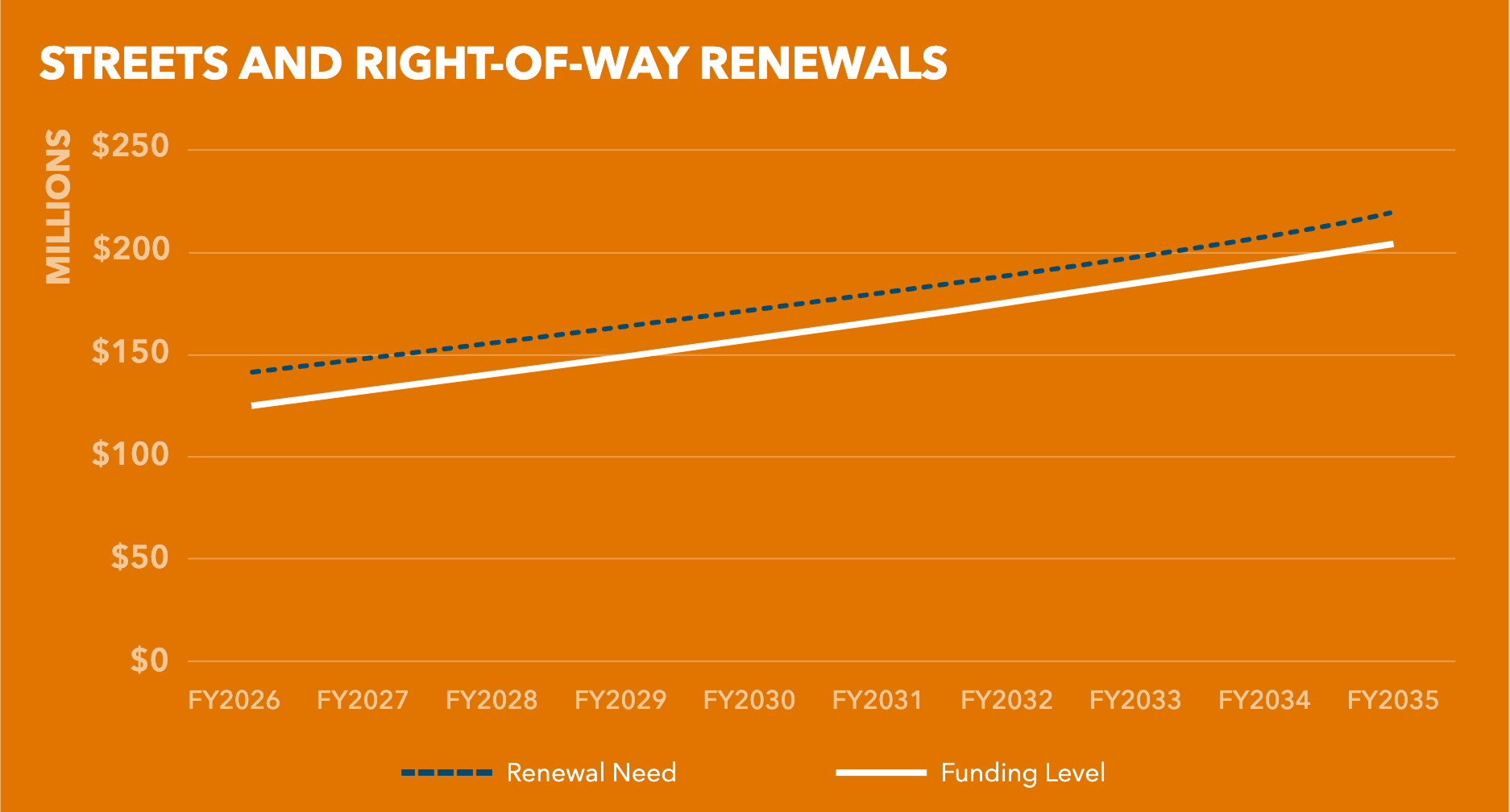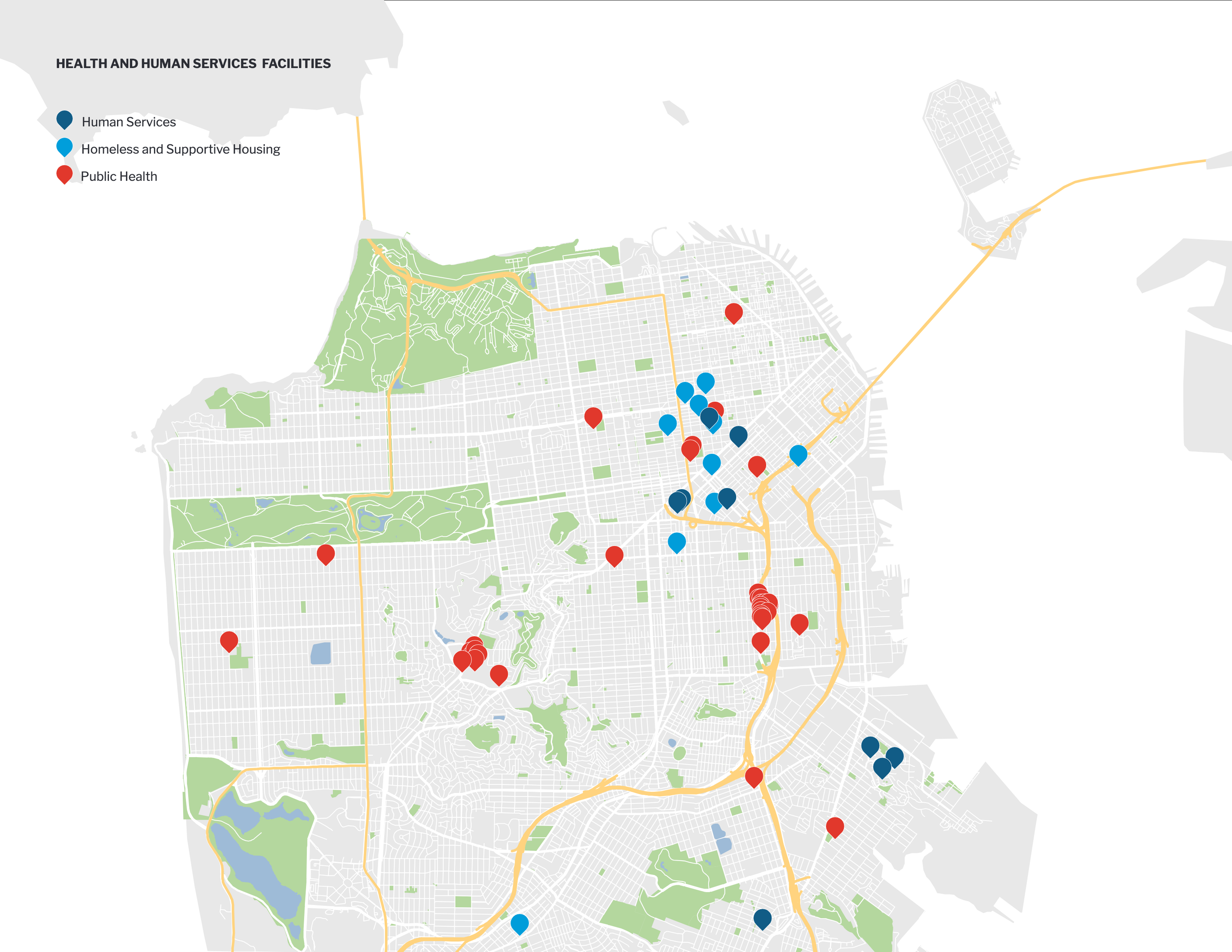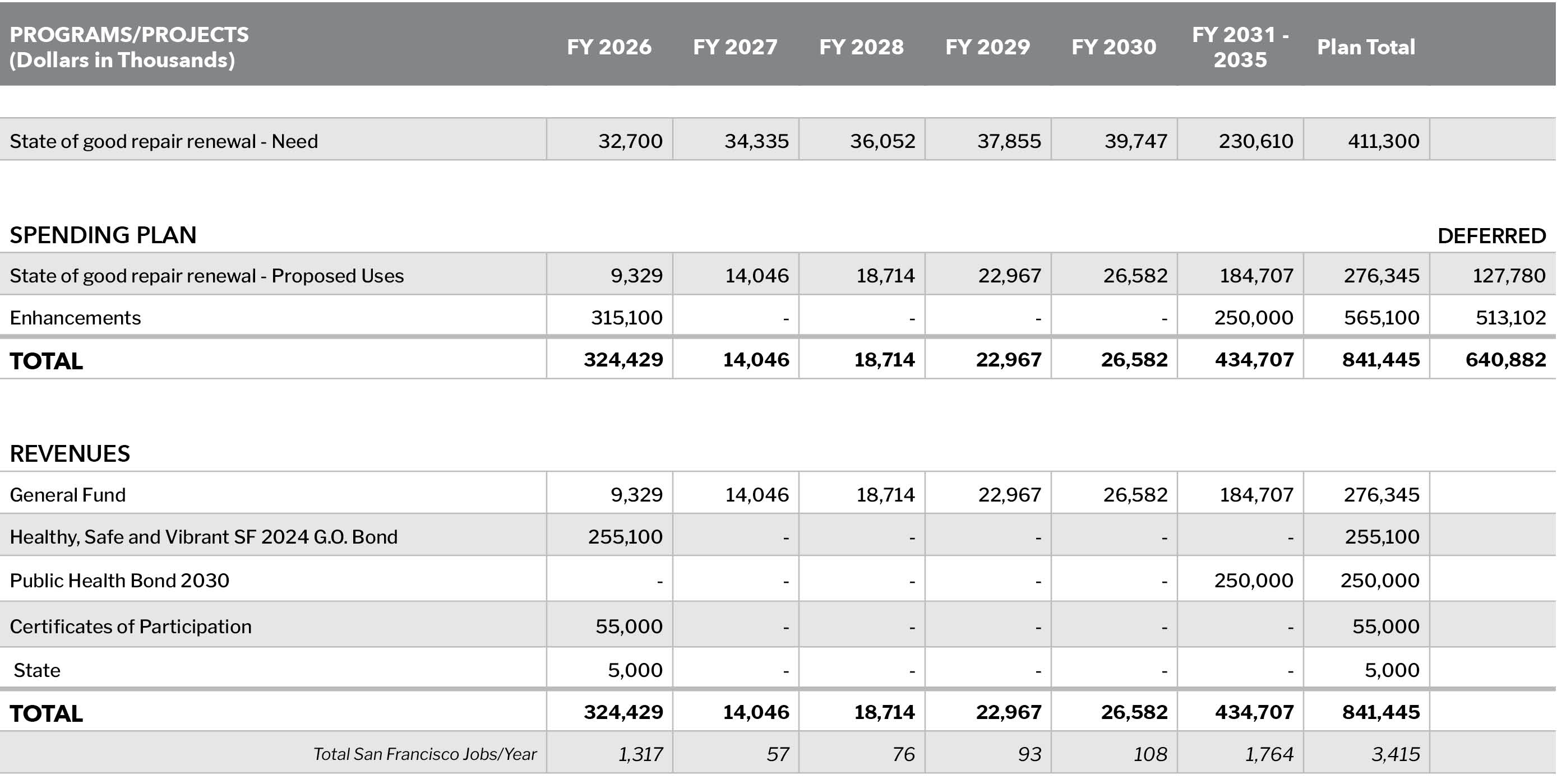|
Project Name
|
Description
|
|
PW – Curb Ramp Inspection
and Repair
|
This project complements the Curb Ramp Program (see Enhancement section below) with funding to inspect and repair detectable tiles on existing ramps.
The estimated cost for curb ramp inspection and replacement is $20.7 million over the next 10 years. The Plan recommends $13.9 million from the General Fund towards this need.
|
|
PW – Landscape Median Maintenance and Irrigation Repair
|
As San Francisco replaces more cement and concrete with green spaces to advance environmental benefits, investment in maintaining these areas keeps them free of trash and hazards and promotes the health of plants. With more than 175 landscaped medians and open spaces across the City, irrigation systems require routine maintenance and repairs to prolong their useful lives and keep the landscaping in good condition. Healthy plants can also help reduce maintenance needs by out competing weeds, reducing labor costs.
The estimated cost for median maintenance is $154.1 million over the next 10 years. The Plan recommends $103.9 million from the General Fund towards this need. In addition, $39.7 million is expected from the State. Public Works also has identified an additional $38.2 million in median enhancement needs.
|
|
PW – Plaza Inspection
and Repair Program
|
Public Works is responsible for maintaining plazas throughout the City, including Blanken- Bayshore, Embarcadero, Hallidie, Harvey Milk, Justin Herman, Mechanics, Mendell, United Nations, Ferry Park, Guerrero, Flying Books, and Jack Kerouac Alley. These plazas require annual inspection to determine the extent of any repairs that may be required.
The estimated cost for plaza inspection and repair is $6.4 million over the next 10 years. The Plan recommends $4.3 million from the General Fund towards this need. Public Works also has identified an additional $15.3 million in plaza enhancement needs.
|
|
PW – Sidewalk Improvements
and Repair Program
|
Public Works maintains sidewalks in three ways: (1) The Bureau of Urban Forestry maintains sidewalks around City-maintained street trees (2) The Bureau of Street-use and Mapping executes the Sidewalk Inspection and Repair Program, with the goal to inspect and repair every block on a 25-year cycle, and (3) The Bureau of Street-use and Mapping runs the Accelerated Sidewalk Abatement Program, a reactive operation that inspects locations based on complaints and issues notices of violation to property owners to compel them to repair their hazardous sidewalks.
The estimated cost for sidewalk improvements and repair is $35.9 million over the next 10 years. The Plan recommends fully funding this need from the General Fund. An additional $33.8 million is expected from other local sources.
|
|
PW – Street Resurfacing
and Reconstruction
|
Public Works oversees the maintenance of 940 miles of streets. Without regular resurfacing treatments, a street could end up costing the City four times more over the course of its life cycle. San Francisco uses the industry standard rating scale called the Pavement Condition Index (PCI) to score its streets. Public Works’ goal is to maintain a PCI of 75, which is considered “good” condition. Insufficient funding to maintain the roads will result in a lower PCI score, which in real terms means more potholes and roadway hazards putting people and vehicles at greater risk of injuries and repair costs.
The estimated cost to achieve and maintain a PCI of 75 is $1.1 billion over the next 10 years. Funding toward this need includes $497 million from the General Fund, and $612 million from a combination of federal, state, and other local sources.
|
|
PW – Street Structure Repair
|
The Capital Plan provides a strategy for the maintenance and renewal of 275 street structures, including retaining walls, stairs, viaducts, tunnels, underpasses and overpasses, plus numerous guardrails throughout the City. Work performed under this program includes general maintenance and major repairs of City street structures to maintain safety and minimize long-term renewal costs.
The estimated cost for other street structure maintenance is $47.2 million over the next 10 years. Given anticipated funding constraints, the Plan allocates $31.8 million from the General Fund towards this need. PW has also identified an additional $93.1 million in Street Structure enhancement needs.
|
|
PW – Street Tree Maintenance
and Sidewalk Repair
|
Public Works is responsible for maintaining approximately 125,000 street trees. Proposition E of the November 2016 ballot, now known by its program name, StreetTreeSF, set aside dedicated annual funding towards this need, providing Public Works the resources to maintain street trees on an average three-to-five-year cycle, inspect all street trees annually, and make street tree-related sidewalk repairs on a similar cycle.
The estimated cost for street tree maintenance and related sidewalk repair is $325.5 million over the next 10 years, of which $259.2 million is funded by the General Fund through Proposition E.
|
|
PW – Bridge Inspection and Repair
|
Public Works is responsible for the inspection and maintenance of three movable over-water bridges and 93 vehicle/pedestrian bridges throughout the City. Work performed under this program includes general inspection and maintenance to bridges to maintain safe and sufficient operations, and to minimize long-term renewal costs.
The estimated cost for ongoing bridge inspection and repair is $6.8 million over the next 10 years. The Plan recommends $4.6 million from the General Fund toward this need. PW has also identified an additional $50.6 million in bridge rehabilitation needs.
|
|
PW – Islais Creek Bridge Rehabilitation
|
The proposed replacement Islais Creek Bridge will meet current structural and seismic standards, be more resilient to projected future sea level rise, and will better accommodate light rail, vehicle, pedestrian, and bicycle demands. The bridge is along a vital arterial, carrying vehicles, pedestrians, bicycles and the SFMTA Metro T line along Third Street, across Islais Creek. The project is critical for public safety as the bridge had been deemed structurally deficient by Caltrans inspection and continues to deteriorate as repairs are deferred.
The estimated cost for the Islais Creek Bridge project is $102.6 million, with $11.8 million being funded by the General Fund, and the remaining $90.8 million anticipated from a Federal grant.
|
|
SFPUC Hetch Hetchy –
Water Infrastructure
|
The Water Infrastructure program provides capital funding for Renewal & Replacement (R&R) and Large Infrastructure projects on HHWP’s assets that are classified by the Water Supply Agreement (WSA) as Water. This Capital Plan funds capital improvements on the San Joaquin Pipelines, Mountain Tunnel, and other water assets.
The cost of SFPUC’s Hetch Hetchy – Water Infrastructure renewal and replacement projects is approximately $186.9 million
through FY2035.
|
|
SFPUC Hetch Hetchy –
Power Infrastructure
|
The Power Infrastructure program provides capital funding for Renewal & Replacement (R&R) and Large Infrastructure projects on HHWP’s assets that are classified by the Water Supply Agreement (WSA) as Power. This Capital Plan funds capital improvements on the power infrastructure projects such as Moccasin Switchyard, Kirkwood Powerhouse, Moccasin Powerhouse, Holm Powerhouse, 115kV and 230kV Transmission Lines, Warnerville Substation, Cherry-Eleanor Pumps, and other power assets.
The cost of SFPUC’s Hetch Hetchy – Power Infrastructure renewal and replacement projects is approximately $278.3 million
through FY2035.
|
|
SFPUC Hetch Hetchy – Water
and Power Joint Infrastructure
|
The Joint Infrastructure program provides capital funding for Renewal & Replacement (R&R) and Large Infrastructure projects on HHWP’s assets that are classified by the Water Supply Agreement (WSA) as Joint. This Capital Plan funds capital improvements on projects such as O’Shaughnessy Dam, Canyon Tunnel, Mountain Tunnel, Moccasin Penstock, Power Distribution Lines, Cherry Dam, Buildings & Grounds, and other joint assets.
The cost of SFPUC’s Hetch Hetchy Water and Power – Joint Infrastructure renewal and replacement projects is approximately $992.6 million through FY2035. These assets are jointly funded by Water (45%) and Power (55%) sources.
|
|
SFPUC Wastewater – Collection System/Condition Assessment Project
|
There are more than 80 miles of major sewers that have been in service for 100 years or more and are at the end of their useful life. This project includes cleaning and inspection of small and large diameter sewers, transport/storage boxes and collection system discharge/overflow structures. The results of the inspection program will inform the Renewal and Replacement Spot Repair and Collection System Sewer Improvements Programs (SSIP), as well as the SSIP sewer repairs. This project is a part of the ongoing data gathering necessary for the Wastewater Enterprise Collection Systems Asset Management Program.
The cost of SFPUC’s Collection System/Condition Assessment Projects are approximately $483.5 million through FY2035.
|
|
SFPUC Wastewater – Collection System/Sewer Improvement
|
This program maintains the existing functionality of the sewage collection system and includes planned and emergency repairs and replacement of structurally inadequate sewers. Failure of the collection system will reduce the City’s ability to handle and dispose of wastewater and stormwater which can lead to public health, safety, and environmental risks, and non-compliance with the State discharge permit. Projects are identified utilizing an asset management approach which factors in physical condition, age, location, risk, public safety, paving schedule, and other factors. This program allows for the renewal and replacement of approximately 15 miles of sewer per year.
The cost of SFPUC’s Collection System/Sewer Improvement is approximately $516.8 million through FY2035.
|
|
SFPUC Wastewater – Collection System/Large Diameter Sewers
|
This is a collection of large sewer improvement projects that will rehabilitate and/or replace Large Sewers (sewers greater than 36-inches in diameter or equivalent diameter) that have the highest risk for failure. These projects (or subprojects) were identified in SSIP Phase 1.
The cost of the SFPUC’s Collection System/Large Diameter Sewer Improvement is approximately $256.0 million through FY2035.
|
|
SFPUC Wastewater – Sewer
Lateral Improvements
|
The R&R Program Collection System Sewer Lateral Improvement projects consist of localized replacement/rehabilitation of sewer assets (predominantly sewer laterals). The State implementation of the Combined Sewer Overflow Policy requires that sewer utilities must have an ongoing inspection, cleaning, and repair program for sewer system assets to minimize raw sewage overflows.
The costs of the SFPUC’s Lateral Sewer Improvement Program is approximately $164.9 million through FY2035.
|
|
SFPUC Wastewater – Treatment Plants
|
The Treatment Plant Improvement program helps maintain the capacity and reliable performance of the Wastewater treatment facilities owned and operated by the Wastewater Enterprise. This is a continuing annual program to extend the useful life of Wastewater treatment assets including transport boxes, discharge structures, pump stations, force mains, tunnels and treatment plants.
The projects are prioritized based upon regulatory compliance, condition assessments, operation staff recommendations, and level of service goals which were formally adopted as part of the SSIP. The completion of projects under the Treatment Plant Improvement program will increase reliability and efficiency of Wastewater Enterprise facilities and ensure that the performance of the treatment facilities meets the established levels of service.
The cost of SFPUC’s Treatment Plants is approximately $355.2 million through FY2035.
|
|
SFPUC Local Water – Water
Supply Projects
|
This program includes planning for local water diversification to explore alternative methods for expanding local water sources. Such sources include the SF Local Groundwater Treatment Program and Recycled Water projects supporting innovations for San Francisco ratepayers that highlight innovative water supplies and technologies.
The cost of SFPUC Water’s Local Water Supply Projects is approximately $32.8 million through FY2035.
|
|
SFPUC Water – Local Water Conveyance/Distribution System
|
This program includes funding to install, replace and renew distribution system pipelines and service connections for the 1,230 miles of drinking water mains in San Francisco to meet customer level of service goals for uninterrupted service. Improvements include replacement, rehabilitation, re-lining, and cathodic protection of all pipe categories to extend or renew pipeline useful life. The program also includes partial funding for new Potable Emergency Firefighting Water System pipelines as well as funding for joint department City street improvement projects.
The Renew Services Program provides funding to renew assets between the water main and the customer's service connection. This program includes the Lead Component Services Program to replace any lead components for the customer’s water service line and the Water Loss Reduction Program to implement cost-effective and comprehensive strategies to reduce water loss. The GIS distribution system mapping program and the Water Quality Distribution Systems are also included.
Additional projects include the New Services Connection Program, Asset Management Platform, and Town of Sunol Pipeline projects.
The cost of SFPUC’s Local Water Conveyance/Distribution System is approximately $750.8 million through FY2035.
|
|
SFPUC Local Water – Systems Monitoring and Control
|
Projects include an upgrade to the Customer Service Center System that will modernize current existing technology to optimize business processes aligning with current and future Customer Service needs and increased operational effectiveness. Continued improvements to facilities for controlling and monitoring San Francisco's water distribution system include enhancements to the Supervisory Control and Data Acquisition (SCADA) system for remote monitoring of pressure, flow, and valve position status at key locations throughout the distribution system.
The cost of SFPUC’s Local Systems Monitoring and Control Program is approximately $13.2 million through FY2035.
|
|
SFPUC Local Water – Local Reservoir and Tanks Improvements
|
This program provides long-term funding for renewal and rehabilitation of water storage reservoirs and tanks within the San Francisco Distribution System. Projects included replacement of coatings for roofs and tanks at multiple locations to extend the useful service life of the facilities, Lombard Reservoir Geotechnical Impartments and Sunset Reservoir Treatment Facility projects.
The cost of SFPUC Water’s Local Tanks/Reservoir Improvements is approximately $22.2 million through FY2035.
|
|
SFPUC Local Water – Pump
Station Improvements
|
The SFPUC’s 12 major water pump stations and seven hydropneumatics tanks that boost pressure within the San Francisco distribution system need ongoing renewal and rehabilitation. This program provides long term funding for renewal and rehabilitation of the water pump stations and hydro-pneumatic tanks that boost water pressure within the distribution system.
Projects included improvements to the Harding Park Pump Station and South Hill and McLaren Pump Station Upgrades.
The cost of SFPUC Water’s Local Pump Stations is approximately $10.0 million through FY2035.
|
|
SFPUC Local Water – Automated Meter Reading System
|
This program provides funding for the ongoing Automated Water Meter Program (AWMP) including meter renewal, replacement, automation, and replacement planning for the entire AWMP System by the end of its 20-year useful life (ending in 2031).
The cost of SFPUC’s Automated Meter Reading System Program is approximately $21.2 million through FY2035.
|
|
SFPUC Water – Local Buildings and Grounds Improvements
|
This program provides funding for capital improvements at City Distribution Division facilities and structures. Projects include yard improvements to address health and safety issues and security, continuing renewal and replacement of aging assets at existing buildings and grounds including vehicle and pedestrian gates, fencing at reservoirs, and exterior lighting improvements at reservoirs and pump stations.
Additional funding is included for a new CDD Headquarters at 2000 Marin to address life safety standards for seismic events, building code requirements and facilities that are past useful life. The 2017 Condition Assessment found all buildings aged, water-damaged, and deficient in meeting seismic, ADA, electrical and other building code standards. Existing facilities include administrative offices, warehouse, shops, materials and equipment storage and vehicle fleet.
The cost of SFPUC Water’s Local Buildings and Grounds Improvements is approximately $283.0 million through FY2035.
|
|
SFPUC Local Water – Emergency Firefighting Water System
|
The Emergency Firefighting Water System (EFWS) delivers high-pressure water necessary to fight large fires. EFWS is jointly developed by the SFPUC and San Francisco Fire Department. SFPUC funds are planned to support the design and construction of earthquake resistant ductile pipeline to improve fire water and potable water supply reliability in the Sunset and Richmond neighborhoods.
The SFPUC has planned $54.0 million from Water Revenue Bonds over the next five years to support western EFWS water supply and pipeline projects. The ESER G.O. Bond is the primary source of funding for EFWS. For additional information on EFWS, including the ESER Bond Program and strategic direction about work on the west side, please see the Public Safety chapter of this Plan.
|
|
SFPUC Regional Water – Regional Water Treatment Program
|
This program provides funding for improvements to the major water treatment facilities located at Tesla, Thomas Shaft Chlorination Facility, Sunol Valley Chloramination Facility, Sunol Valley Water Treatment Plant (SVWTP), Pulgas Dechloramination facility, Harry Tracy Water Treatment Plant (HTWTP), and other locations. Major projects include SVWTP Ozone project to install ozone treatment facilities as a long-term solution to control taste and odor events encountered in the raw water supply from both the San Antonio and Calaveras Reservoir sources. Other projects include HTWTP Electrical Substation Upgrades, and other short-term and long-term improvements at SVWTP to improve regional delivery reliability by addressing various conditions and deficiencies of the SVWTP.
The cost of SFPUC Water’s Regional Water Treatment Program is approximately $141.7 million through FY2035.
|
|
SFPUC Regional Water – Regional Water Transmission Program
|
This program provides upgrades to the Transmission System including pipeline inspection and repairs, pipeline and valve replacements, metering upgrades, corrosion protection, and pump station and vault upgrades. As part of the pipeline improvement program, funding is included to monitor, strengthen, and replace older pipeline to achieve higher level performance and reliability. Funding included for the Crystal Springs Pipeline 2 & 3 Rehabilitation will relocate and replace approximately 1.5 miles of 60-inch diameter pipe into Crystal Springs Road, reline sections of the pipe with cement mortar lining, and upgrade appurtenances to meet current standards and the Palo Alto Pipeline Replacement Project.
The cost of SFPUC Water’s Regional Water Transmission Program System is approximately $409.5 million through FY2035.
|
|
SFPUC Regional Water – Regional Water Supply and Storage Program
|
This program includes upgrades to reservoir dams and structures to meet State Division of Safety of Dams requirements including geotechnical work, installation of monitoring systems, and major improvements to dam spillways and structures as needed. Projects included Pilarcitos Dam Improvements and the San Andreas Dam Facilities Upgrades.
The cost of SFPUC Water’s Regional Water Supply and Storage Program is approximately $107.4 million through FY2035.
|
|
SFPUC Regional Water – Regional Watersheds and Land Management
|
This program supports projects that improve and/or protect the water quality and/or ecological resources impacted by the siting and operation of SFPUC facilities. Projects include the repair, replacement, maintenance, or construction of roads, fences, or trails, the acquisition of easements and/or fee title of properties, and other ecosystem restoration or public access, recreation, and education projects. New to the plan is the Phase 2 Alameda Watershed Center Project to improve the reliability and functionality of the facility.
The cost of SFPUC Water’s Regional Watersheds and Land Management is approximately $14.5 million through FY2035.
|
|
SFPUC Regional Water –
Regional Communications
and Monitoring Program
|
This project will provide much needed redundant emergency communications capability and increased bandwidth for secure data transfer. Specifically, it will build a microwave backbone to link the entire SFPUC regional water system from the O’Shaughnessy Dam site in Yosemite to the rest of the SFPUC sites (San Francisco, San Mateo, Santa Clara, and Alameda counties).
The cost of SFPUC Water’s Regional Communications and Monitoring Program is approximately $18.7 million through FY2035.
|
|
SFPUC Regional Water – Regional Buildings and Grounds Programs
|
This program provides funding for major improvements to the Sunol and Millbrae Yards. Sunol Yard improvements include LEED replacement facilities for maintenance shops and equipment storage, a new fueling center and administration building, re-surfacing of the yard, demolition of six dilapidated structures, and ongoing renewal and replacement of worn or aging equipment. Millbrae Yard improvements include a new laboratory and office building to update the lab facilities and consolidate staff from the Rollins Road facility, maintenance shop, and equipment storage; demolition of a large unused abandoned building; a new parking lot; and a new vehicle wash site. The upgrades address occupational safety, reliability, and functional regulatory compliance.
The cost of SFPUC Water’s Regional Buildings and Grounds Programs is approximately $424.2 million through FY2035.
|
|
SFPUC Regional Water – Long-Term Monitoring & Permit Program
|
The purpose of this program is to meet the long-term monitoring and permit requirements associated with capital projects and the operation and maintenance of the SFPUC water supply system and watershed/right-of-way lands within the Bay Area. Projects with long-term monitoring required by environmental permits include Water System Improvement Program (WSIP) related environmental mitigation and permit requirements (i.e., Bioregional Habitat Mitigation Program) and non-WSIP capital projects.
The cost of the SFPUC Water Regional Long-Term Monitoring & Permit Program is approximately $39.1 million through FY2035.
|

